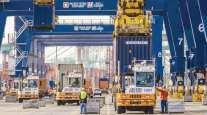Senior Reporter
Port Leaders to Meet Amid Rapidly Changing Environment

[Stay on top of transportation news: Get TTNews in your inbox.]
Uncertainty over labor negotiations at West Coast ports and East Coast facilities seeing a surge in business are just two signs port industry leaders see in a rapidly changing environment.
Now, more than 2½ years into the COVID-19 pandemic, and with the economy showing signs of slowing, industry experts say they are confident that their facilities can handle almost any situation because they have endured some of the most challenging conditions in the last fifty or more years.
“Let’s face it, the one thing we’ve learned from the pandemic is we need a diversified gateway system in our country for cargo to come into and go out of,” American Association of Port Authorities CEO Chris Connor told Transport Topics. The organization’s Annual Convention and Expo runs Oct. 16-19 in Orlando, Fla.

Connor
Within the sea change in the industry, the Port Authority of New York and New Jersey last month overtook the ports of Los Angeles and Long Beach as the nation’s busiest.
“New York is, you know, now the biggest cargo port in the country,” Connor said. “There is some hedging going on by importers who rerouted cargo that probably historically has gone into Southern California or other gateways and they’ve rerouted it to East Coast ports. The expansion of the Panama Canal in 2016 is another factor why cargo is picking up on the East Coast. But Southern California has an advantage in terms of its location, and it has a lot of economic advantages and logistics advantages.
RELATED: West Coast Ports May Permanently Lose Volume Share to East Coast
“So we’ll just have to wait and see how it plays out in the long term, but I think we are 18 to 24 months before we see the really positive things happen because of those investments.”
Ret. General Stephen Lyons, Port & Supply Chain Envoy @WhiteHouse Supply Chain Disruptions Task Force, & Major General Graham, Deputy Commanding General for Civil and Emergency Operations, @USACEHQ to speak at AAPA Annual Convention & Expo Register today https://t.co/4P8rWL4iAj pic.twitter.com/4Ake6HZ4hq — AAPA (@AAPA_Seaports) September 1, 2022
Connor said one factor that will dramatically improve port operations in the coming years was President Joe Biden’s signing of the $1.2 trillion infrastructure bill last November. More than $17 billion is directed to ports, and that does not include the hundreds of millions being spent by state and local governments. Those funds are meant to improve facilities from an efficiency standpoint, making them more accessible to both truck and rail lines, and to accommodate ships capable of transporting more than 15,000 20-foot-equivalent units.
“We’re starting to have conversations with policymakers about the bipartisan infrastructure law, and the Inflation Reduction Act also contains about $3.5 billion for electrification of port operations,” Connor said. “Both of those have five- to six-year funding windows if we want to keep the private sector players engaged and we want to keep those dollars as well investing in our intermodal and port economies. But we need the federal government to make commitments to be a partner for the longer term beyond those five-year funding periods.”

TT's Eugene Mulero joins host Mike Freeze to discuss the midterm elections, and what the fight for control of Congress will mean for trucking. Tune in above or by going to RoadSigns.ttnews.com.
Other port leaders have said that for too many years the nation’s facilities have been underfunded and those such as the Port of Amsterdam and China’s ports including Shanghai have modernized and expanded their operations, making them among the largest and most efficient in the world.
“I think that from an investment standpoint, it is probably the most important that it is not just a political cycle that is driving this investment, but it really is a strategic decision, made by the government to invest in the critical infrastructure of the ports and the intermodal connectivity,” Connor emphasized. “I think we can learn some things from some ports in both Europe and in Asia, and I hope as part of this renaissance or golden area that I referred to, there’s an opportunity to lean on some of that experience that’s out there.”
As the port officials convene, the labor talks in San Francisco between the 22,000 members of the International Longshore and Warehouse Union and the Pacific Maritime Association continue. The sides have reached a tentative agreement on some key points, including health care, but critical issues remain, such as pay and work rules, including management’s desire to introduce more automation.
Want more news? Listen to today's daily briefing above or go here for more info
Port leaders also are watching the ongoing railroad talks between the six Class I freight railroads and the management team that is negotiating on their behalf.
“I am, and all the port leadership are following those talks between the ILWU and the PMA very closely,” Connor said.
Those railroad talks may have hit a setback Oct. 10 when one of the smaller unions announced its members had turned down a tentative agreement that White House and labor groups announced Sept. 19 that avoided, at least for now, a nationwide railroad strike that would have hit just as the holiday retail season is set to begin.
Still, Connor is optimistic that issues will be resolved as, he said, they tend to do.
“Our job is to educate people about the ports,” Connor said, “so that we can all make the best decisions about how to move the freight and get it to consumers.”




